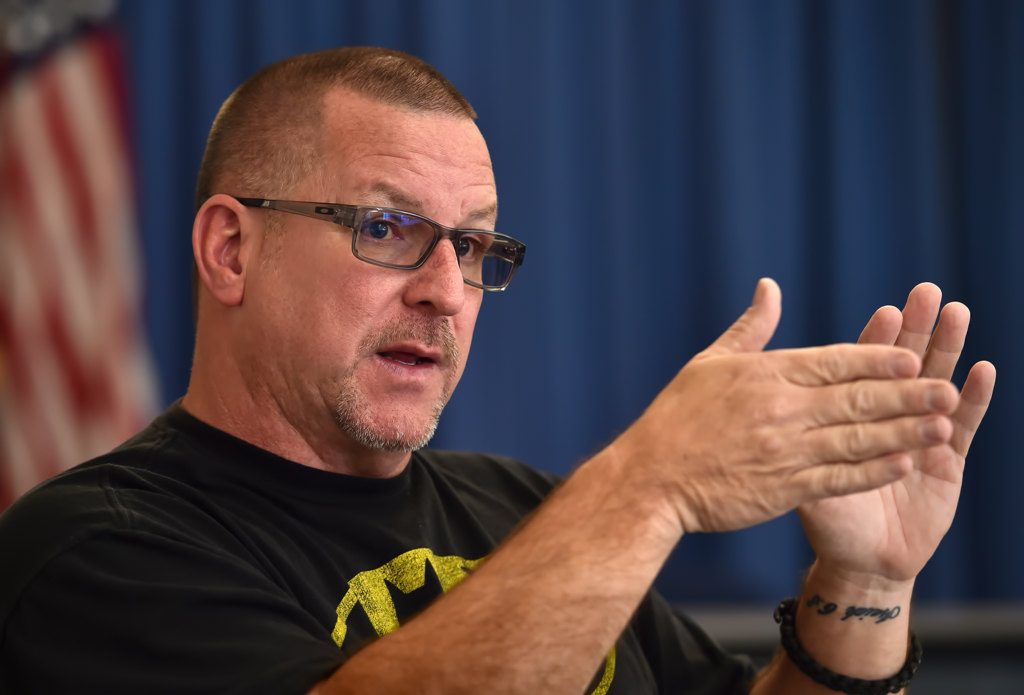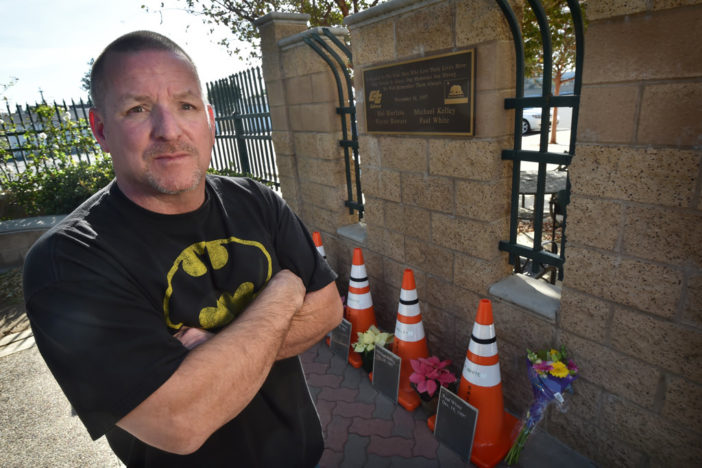The call went out over Orange PD dispatch at about 3 p.m. on Dec. 18, 1997.
“Possible 245 shooting victim at 1785 N. Batavia … something about a male subject with a shotgun … more to follow.”
Orange PD Officer Derek Cook was the first to respond to the scene at the Caltrans yard on Batavia Street, just north of Taft Avenue.
Cook put out a radio blast, providing a second-by-second account of the frenzied scene unfolding in front of him:
“10-33 (officer needs help) Shots fired! Shots fired! People down! … I need somebody up here now! … He’s got an AK-47!”
Dispatcher: “All units be advised. Male subject, possibly armed with an AK 47 … Multiple people down.”
Cook: “Officer hit! Officer hit!”
Firing his handgun, vs. the shooter and his AK-47, Cook took the guy out with two shots to the chest and one to the head, putting an end to the deadliest shooting in OPD history.
“All units. Cease fire! He’s down! I got him down!”
Before it ended, Arturo Reyes Torres, a disgruntled former Caltrans employee who recently had been fired for theft, shot and killed four Caltrans workers and wounded two others.
He also wounded Orange PD Officer John Warde, a father of two who was engaged.
On the 20th anniversary of the deadly event, Warde, who now lives in Central California, recently recounted the incident from an OPD conference room.
Warde had been assigned to the bicycle unit, but it was raining so hard that day he was assigned to a patrol car.
Warde happened to be in dispatch when the first call came in.
“On a day shift, the majority of calls involving shots being fired wind up being nothing,” Warde said.
Not this time.
When the first call went out, Cook was only a half block from the Caltrans yard and the first to respond.
He was walking through the parking lot toward the Caltrans building about the same time Torres emerged from the back section of the yard spraying bullets.
The two made eye contact.
Torres took aim at Cook and started shooting.
“Those type of rounds … it’s a horrific round,” Warde said. “It was just exploding everything around him.”
Even while he was being shot at, Cook was putting details out over the radio “trying to keep himself alive for that amount of time,” said Warde, who sped to the scene along with his partner.
Torres was able to get to his car and drive off, but didn’t get far before being pinned in traffic at Batavia and Taft.
Torres got out of his car, crouched behind the driver’s side door and started shooting at Cook and Warde, who had arrived in a second unit with his partner.
There was an exchange of gunfire. Warde recalls getting off about 11 or 12 shots from the passenger seat of the patrol car.

Former Orange PD Officer John Warde talks about the deadly shooting at the Caltrans Maintenance Station in Orange on Dec. 18, 1997.
Photo by Steven Georges/Behind the Badge OC
Warde was outside the car and moving toward the back of the unit, when “Bang!” he said.
The round from the AK-47 entered Warde’s torso through his lower back and tore through his body with such force it exited through his stomach and put a dent in the trauma plate on the front of his bullet-proof vest.
“It just basically shows you the type of force that kind of round has,” Warde said. “Luckily for me, I did have the vest on, because it held everything together.”
Warde compared the sensation of being shot to being pushed hard in the back.
“I kind of stumbled and got back to my feet and went to the back of the car to get cover,” Warde said. “I reloaded my gun.”
Suddenly, breathing became almost impossible.
That’s when Warde knew the round had punctured his right lung.
“I couldn’t get enough air to put out a call on the radio,” he said.
Warde managed to get into the back of another patrol unit and was whisked off to the hospital by fellow officers.
Meanwhile, Cook decided to take on Torres.

This plaque honors Orange PD Officer John Warde, who was wounded in the Caltrans shooting on Dec. 18, 1997 that left four people dead. It hangs on a wall at the Orange Police Department.
“I started walking right toward him and started engaging him,” said Cook, who put the shooter down with three shots.
More than 300 bullets were fired in all, police say.
There happened to be a doctors’ conference at St. Joseph’s Hospital when Warde arrived.
He was worked on by a renowned abdominal surgeon who mended Warde’s intestine along with his lung.
“You’ve got to have the mentality of, ‘We are going to get through this,’ otherwise you go down the wrong road and it’s over for you,” said Warde, recalling his mindset at the time. “You’ve got to stay positive.”
Warde spent a month in the hospital and wound up being married from his hospital bed two days before he was scheduled to go home. He eventually returned to work and retired after a few years.
Police have no doubt Torres likely was heading to another Caltrans yard along Tustin Avenue where he would have taken more innocent lives had he not been taken out by Cook.
Caltrans workers whose lives were taken that day were Hal Bierlein, 51; Wayne Bowers, 43; Michael Kelley, 49; and Paul White, 40.
Two other employees, Reginald Tennyson, 54, and Jesus D. Barrios, 36, were wounded.
Cook received the department’s Medal of Valor for his actions that day.
Nine other officers were awarded the department’s Medal of Courage, and dispatcher Mike Taylor was given the Medal of Distinction.
“I just can’t stress enough how well everyone performed that day,” said Cook, who retired in 2016 and moved out of state. “Everyone did a great job. We were working together as one.”
A memorial with the victims’ names was erected at the Caltrans yard, and Warde made it a point to lay flowers at the base of the memorial on the 20th anniversary of the killings.
Cook spent the anniversary of the shooting the same way he has spent every previous anniversary.
“I think about the families 20 years later,” Cook said. “How do they feel?”
 Behind the Badge
Behind the Badge



